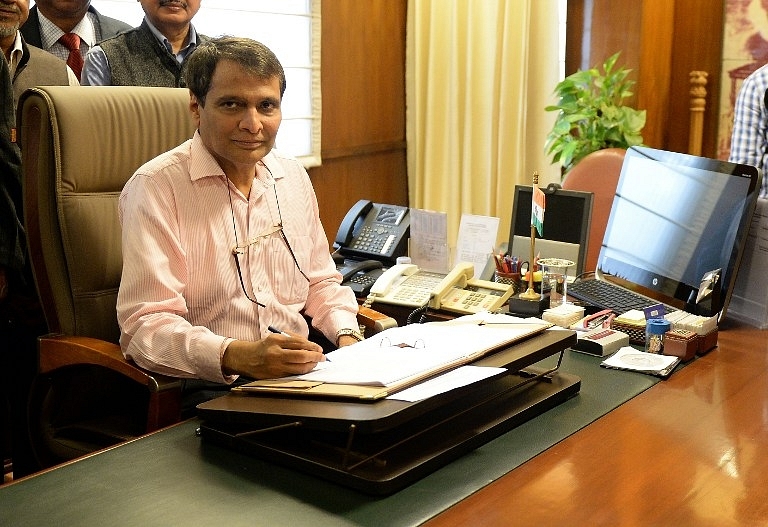Economy
10 Yardsticks To Judge Rail Minister Suresh Prabhu’s Record In 2015-16
- Ten things we must watch out for in 2016 Railway Budget.

Railway Minister Suresh Prabhu
In a couple of hours from now, we will hear Railway Minister Suresh Prabhu deliver his second budget speech. Since economic revival and job creation depend crucially on two key infrastructure ministries – railways and road transport, run by Prabhu and Nitin Gadkari respectively – we will get early answers on how one of them has fared today (25 February).
The questions we need answers for are
the following:
#1:
Has Prabhu decisively broken the cycle of underinvestment in railways, and by
how much in his first year?
#2: Has
Prabhu put the Indian Railways on the path to economic sustainability, where
operating margins are high enough to finance growth and investment?
#3: Has
the quality of user experience – both passengers and freight users – improved?
What are the metrics being used to measure improvements in customer
satisfaction?
#4: Has
safety started improving, by a steady reduction in man-made and unexpected accidents?
These are not goals I have set for
Prabhu, but those he has set for himself, and so this is how we should measure
his performance.
While actual results may vary
depending on economic conditions and the climate for growth, which has not
improved, we thus need to add six more parameters to judge Prabhu’s
performance, and how short he may have fallen from them. So here are the six
other yardsticks that are more specific than the broader goals above, and some
of them are about measuring the current’ year’s performance.
#5:
Given that the economy has not gathered steam, how much will Prabhu fall short
of his ambitious freight traffic earnings target of Rs 1,21,423 crore in
2015-16, of which only one month remains? How much will he fall short of the
planned increase in freight movement by 85 million tonnes? Any shortfall in
excess of a third of the increased target is not a happy augury.
#6:
How far away will Prabhu be from his targeted operational ratio of 88.5
percent, from 91.8 percent in the year before? Minister of State for Railways
Manoj Sinha has already told Swarajya
in a pre-budget interview that the target will be missed; the question is how
big is the slippage? If the ratio is worse than in 2014-15, that would be a
major blow for the railways’ economic sustainability, especially since next
year (2016-17) the railways will face the additional burden of the Seventh Pay
Commission. Prabhu had pencilled in a growth of gross traffic receipts by 15.3
percent while containing ordinary working expenses to 9.6 percent; while he
could have contained the latter, it is doubtful if he has managed the former in
2015-16.
#7:
Crucially, since the idea is to make the Indian Railways an engine of growth,
Prabhu will be judged by whether he has at least achieved his investment goals.
In 2015-16, he had pencilled in a plan investment of Rs 1,00,011 crore, up 52
percent from the previous year. If the slippage is more 20 percent, it would be
a let-down.
#8:
Another investment target is Rs 8,56,020 crore over five years. How much of
this target has been achieved in 2015-16, when resources are admittedly low and
investment may be slow to pick-up? If he hasn’t covered even 10-12 percent of
the distance, he is unlikely to make the larger target by the terminal year of 2019-20.
#9: Train
speeds are another key measurement area for railway performance. Prabhu
promised an increase in freight train speeds to 100 km for empty trains and 75
for loaded ones, though this is not for one year. On nine major railway
corridors, he promised an increase in passenger train speeds to 160-200 from
110-130. The only thing to measure this year is a simple one: has the average
speed at least risen by 5 km from the year before? One hopes Prabhu has the
numbers to enlighten us on this.
#10:
Last year, Prabhu made a unique departure from the past by announcing no new
projects, stating that completing existing projects is more important than just
blindly announcing new ones and grossly underfunding them. He said the payoffs
from expanding existing lines would be greater than creating new ones. He said:
“We intend to fast track the sanctioned works on
7,000 km of double/third/fourth lines and commission 1,200 km in 2015-16 at an
investment of Rs 8,686 crore. We also intend commissioning 800 km of gauge
conversion. Additionally, we have sanctioned 77 projects covering 9,400 km of doubling/tripling/quadrupling
works along with their electrification at a total cost of Rs 96,182 crore which
is over 2,700 percent higher in terms of amount sanctioned in 2013-14, 2014-15
being a Plan holiday.”
Put another way, Prabhu promised a year of consolidation and changes in a positive direction where delivery would be more important than promise. His budget speech today should be judged from this standpoint.
Support Swarajya's 50 Ground Reports Project & Sponsor A Story
Every general election Swarajya does a 50 ground reports project.
Aimed only at serious readers and those who appreciate the nuances of political undercurrents, the project provides a sense of India's electoral landscape. As you know, these reports are produced after considerable investment of travel, time and effort on the ground.
This time too we've kicked off the project in style and have covered over 30 constituencies already. If you're someone who appreciates such work and have enjoyed our coverage please consider sponsoring a ground report for just Rs 2999 to Rs 19,999 - it goes a long way in helping us produce more quality reportage.
You can also back this project by becoming a subscriber for as little as Rs 999 - so do click on this links and choose a plan that suits you and back us.
Click below to contribute.
Latest